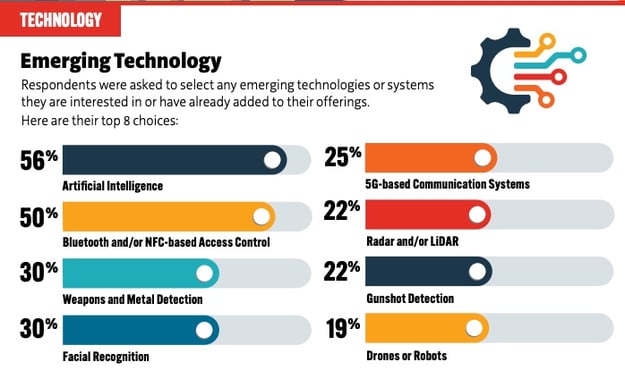The security industry is, of course, ever-changing. That’s why it’s important to stay on top of industry trends and progressions to make sure you’re not falling behind when it comes to adapting and not becoming victim to the status quo. It's essential not to be complacent in this line of work.
HiveWatch recently partnered with SecurityInfoWatch.com for a roundtable featuring Shaun Castillo, President of Preferred Technologies LLC, John Nemerofsky, Chief Operating Officer of SAGE Integration, and Michael Ruddo, Chief Strategy Officer of Integrated Security Technologies, and panel moderator Steve Lasky, Editorial Director of SecurityInfoWatch.com.
During the roundtable, “Deep Dive: The Security Business State of the Industry Report” panelists dove into the results of the annual Security Business State of the Industry report and took a closer look at the trends and strategies for success.
Here are 3 key insights from the webinar discussion:
- How security companies have had to adapt:
With supply chain woes, the effects of the pandemic, and other factors affecting business operations and revenue in the security industry, security companies have had to adapt by providing more services and offering closer collaboration with clients to create more holistic and comprehensive security programs.
Michael Ruddo, Chief Strategy Officer of Integrated Security Technologies, stated, “The environment of the last 3 years forced you to take a hard look at your business because things changed dramatically due to COVID. I feel like it brings you much tighter back to that point of collaboration with your client. You're having conversations that may not always be security-specific. They're basically about how the day-to-day operations run and how you can help that client with that and make them more efficient."
Companies can utilize valuable tools for increasing efficiency, such as software that links together data from all access points and video cameras in a holistic and unified platform, like HiveWatch, which takes into account the entire security program. Technology such as the HiveWatch operating system also provides a centralized place to understand the performance of physical security people and technologies, leveraging analytics and data to allow for quick reactions to incidents, false alarm events, and new threat detection, ultimately increasing productivity and maximizing staff efforts.
Aside from COVID, supply chain, and the economy, 71% of the industry report respondents listed hiring and retaining qualified employees as their top business challenge. The webinar panelists discussed offering flexibility and a robust benefits package, and developing an open and supportive company culture as ways to find and keep qualified employment candidates. You can read our blog on keeping your GSOC engaged and get our Workforce and Retention Guide for more tips on hiring and retaining quality employees!
- Emerging technology:
Artificial intelligence and machine learning are coming up as two of the most anticipated new technology features that can be utilized to help accelerate the decision-making process and alleviate the overload of information that security operators need to respond to.
As Shaun Castillo, President of Preferred Technologies LLC said, “We see more and more sensors in the field. We see less and less users available to process all of the information and they're required to process all of the sensor inputs and make sound decisions in real time. It's just tough to do. So we've got to bridge that gap.
And I think machine learning and artificial intelligence are two great ways to do that. They allow a user to process a preponderance of information and boil it down to actionable intelligence. So I think there's some great opportunities there, not just to respond to security events, but to address other items within the enterprise as well. And as we continue to look for ways to get service to our customers, having teams that can embed with our customer base, really learn their business well and then take our knowledge of security products and apply it not only to securing the business but their whole enterprise, the more value we give that customer.”
- The challenges of having disparate systems and establishing standardization:
Michael Ruddo, Chief Strategy Officer of Integrated Security Technologies said: “Standardization. That's a huge positive, and you want to get there with your client so that there's not a hundred disparate systems out there that you have to know."
With the pressures and requirements to remain within deadlines and budgets, a software solution, such as HiveWatch's Operating System, would be a smart choice for uniting disparate systems. This takes away the need to rip and replace legacy security technology, or spend monetary resources limited to buying one type of system and waiting for the supplies if they're delayed in production. If security leaders are limited by their budgets to replace security technology and standardize their hardware and technology, there are current platforms, like HiveWatch, available to help integrate and fuse together current disparate security systems. This is especially critical when products are on back-order, and there are supply chain issues preventing orders and slowing down projects that are time-sensitive.
"We see more and more sensors in the field. We see less and less users available to process all of the information and they're required to process all of the sensor inputs and make sound decisions in real time. It's just tough to do. So we've got to bridge that gap.
And I think machine learning and artificial intelligence are two great ways to do that. They allow a user to process a preponderance of information and boil it down to actionable intelligence. So I think there's some great opportunities there, not just to respond to security events, but to address other items within the enterprise as well."
Learn more about the HiveWatch Operating System and how it fuses disparate systems and leverages artificial intelligence.








